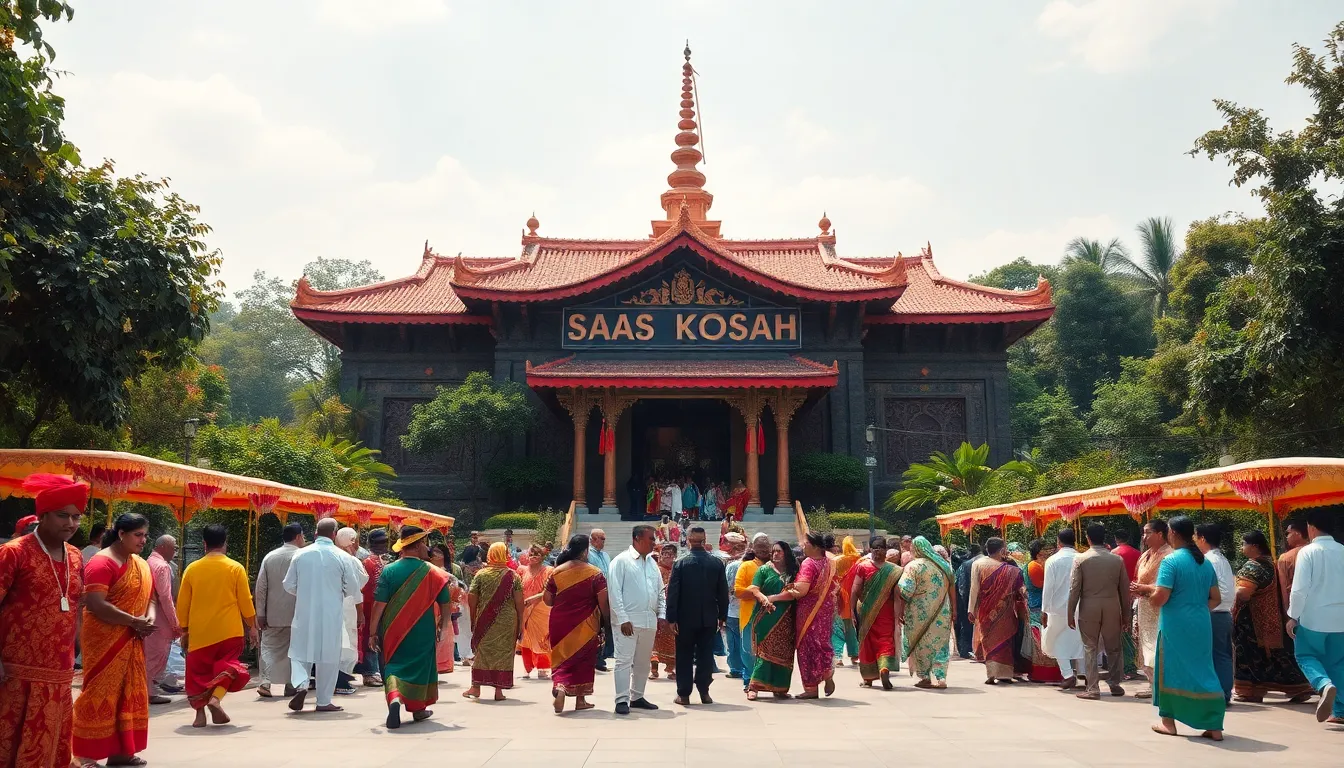Table of Contents
ToggleNestled in the heart of a vibrant landscape, the SaaS Kosah Shrine stands as a beacon of spiritual curiosity and cultural richness. This hidden gem isn’t just another stop on the tourist trail; it’s a portal to ancient traditions and fascinating stories that will leave anyone enchanted. Visitors can’t help but marvel at its intricate architecture and the serene atmosphere that envelops the site.
Overview of Saas Kosah Shrine
Saas Kosah Shrine stands as a pivotal spiritual site, deeply rooted in cultural history. This shrine attracts numerous visitors each year, drawn by its distinct architectural features and serene surroundings. Visitors often appreciate the intricate carvings and vibrant colors that adorn the structure.
The shrine serves various rituals and ceremonies, reflecting a blend of ancient traditions and contemporary practices. Spiritual seekers connect with the rich heritage, while tourists marvel at the beauty of the site.
Many local legends surrounding the shrine contribute to its allure. These stories resonate with both the faithful and those curious about the area’s past. Events held here throughout the year foster a sense of community, bringing individuals together in celebration and reverence.
In addition to its cultural significance, the shrine provides a space for introspection and peace. Individuals often find solace within its tranquil grounds, away from daily distractions. The surrounding landscape enhances the shrine’s atmosphere, making it a picturesque setting for reflection.
Accessibility to Saas Kosah Shrine adds to its appeal. Well-marked paths lead visitors directly to its entrance, ensuring ease for those seeking spiritual experiences. Often, guides share informative insights about the shrine’s history, enhancing the overall experience.
Overall, Saas Kosah Shrine represents an extraordinary synthesis of spirituality, architecture, and community engagement, captivating all who visit.
Historical Significance

SaaS Kosah Shrine holds deep historical significance within its community, showcasing a blend of spirituality and cultural heritage. The shrine stands as a testament to the enduring traditions that echo through generations.
Origin of the Shrine
Origins of the shrine trace back several centuries, rooted in local folklore and spiritual beliefs. It is believed to have been established as a place where divine encounters occurred, attracting early devotees. Founders of the shrine sought to create a space for worship and reflection, cementing its role in the spiritual landscape. Architectural elements reflect the cultural influences of the era, illustrating the craftsmanship and artistry of local artisans. Over the years, the shrine transformed into a refuge for those in search of solace, becoming a symbol of hope and resilience for the community.
Key Events in History
Key events throughout history have shaped the shrine’s significance in the region. Notably, annual festivals draw thousands of visitors, celebrating the shrine’s legacy and fostering a sense of unity. Historical ceremonies held at this site stand as crucial moments in honoring ancestral traditions. Campaigns for preservation in the late 20th century revitalized interest in the shrine, ensuring its survival for future generations. Throughout various conflicts, the shrine remained a safe haven, reflecting the community’s unwavering spirit. Educational programs initiated by local organizations emphasize its importance, highlighting the shrine as a vital link to past heritage and communal identity.
Cultural Importance
SaaS Kosah Shrine holds significant cultural value, acting as a beacon of ancient traditions and community cohesion. Its vibrant atmosphere fosters an appreciation for both spiritual and historical narratives.
Local Traditions and Rituals
Local traditions thrive at the SaaS Kosah Shrine. Each year, the shrine hosts unique rituals, allowing practitioners to engage with their spirituality. Ceremonies reflect the rich tapestry of community life, showcasing vibrant dances and music that resonate with attendees. Seasonal festivals draw in crowds, providing opportunities for communal worship and celebration. Visitors often witness the collaborative efforts of locals, enhancing their connection to the shrine. Sacred events intertwine with daily activities, ensuring cultural practices remain alive and visible.
Influence on the Community
The shrine’s influence on the community is profound. It serves as a gathering point for residents, uniting individuals through shared beliefs. Local artisans often collaborate with the shrine, offering handcrafted goods that embody cultural heritage. Educational programs related to the shrine foster a sense of belonging among residents. Those programs emphasize traditional knowledge passed down through generations. Engagement in shrine activities enriches community spirit, inspiring pride in local history. As a vital link to the past, the SaaS Kosah Shrine reinforces identity and solidarity among its visitors and the wider community.
Architectural Features
The SaaS Kosah Shrine showcases an impressive blend of intricate design and structural elegance. Highlighting cultural significance, its architecture draws visitors from all backgrounds.
Design and Structure
Made predominantly from local stone, the shrine features an array of detailed carvings that depict historical events and spiritual symbols. Visitors often notice its towering spires, which symbolize a connection between earth and the divine. The layout incorporates open courtyards, allowing natural light to illuminate sacred spaces. An ornate gateway stands as the main entrance, welcoming pilgrims and tourists alike. This architectural style reflects traditional motifs, creating a harmonious relationship with the shrine’s surroundings.
Notable Artifacts
Inside the shrine, various artifacts convey the depth of its spiritual heritage. Ancient manuscripts serve as valuable texts documenting rituals and beliefs. Statues of deities, crafted with remarkable detail, attract admiration and devotion. Intriguing relics such as ceremonial vessels enhance the shrine’s historical narrative. Each artifact plays a role in the shrine’s cultural tapestry, enriching the visitor experience. Local artisans often contribute their creations, reflecting ongoing traditions and craftsmanship.
Visitor Experience
The SaaS Kosah Shrine offers an engaging experience for all visitors. Its serene environment and rich history create a memorable visit.
Best Time to Visit
Visiting during festivals provides an immersive cultural experience. Spring attracts locals and tourists to seasonal celebrations that showcase traditional performances. Autumn presents an opportunity to witness special rituals, enhancing the spiritual atmosphere. Temperatures remain moderate from late spring to early fall, making outdoor exploration enjoyable. Rainy season occurs in winter, which can limit outdoor activities but may enhance the tranquility of the site. Planning around local events ensures a deeper connection with the shrine’s heritage.
Tips for Travelers
Keeping a respectful demeanor is essential when exploring the shrine. Visitors should dress modestly to honor cultural traditions. Guided tours offer historical insights, enriching the overall understanding of the location. Attending ceremonies presents an opportunity to witness practices first-hand. Photography is allowed, but capturing respectful moments is important. Local vendors sell handcrafted goods, so supporting artisans contributes to the community’s livelihood. Arriving early helps avoid crowds and allows peaceful reflection in the shrine’s serene atmosphere.
The SaaS Kosah Shrine stands as a testament to the enduring power of culture and spirituality. Its intricate architecture and serene environment create a unique experience for visitors seeking both reflection and connection to history. The vibrant community surrounding the shrine fosters a sense of belonging and pride, making it a vital part of local heritage.
As more people discover its beauty and significance, the shrine continues to inspire wonder and curiosity. Whether drawn by its rich stories or the allure of ancient traditions, those who visit leave with a deeper appreciation for the cultural tapestry that the SaaS Kosah Shrine represents.




